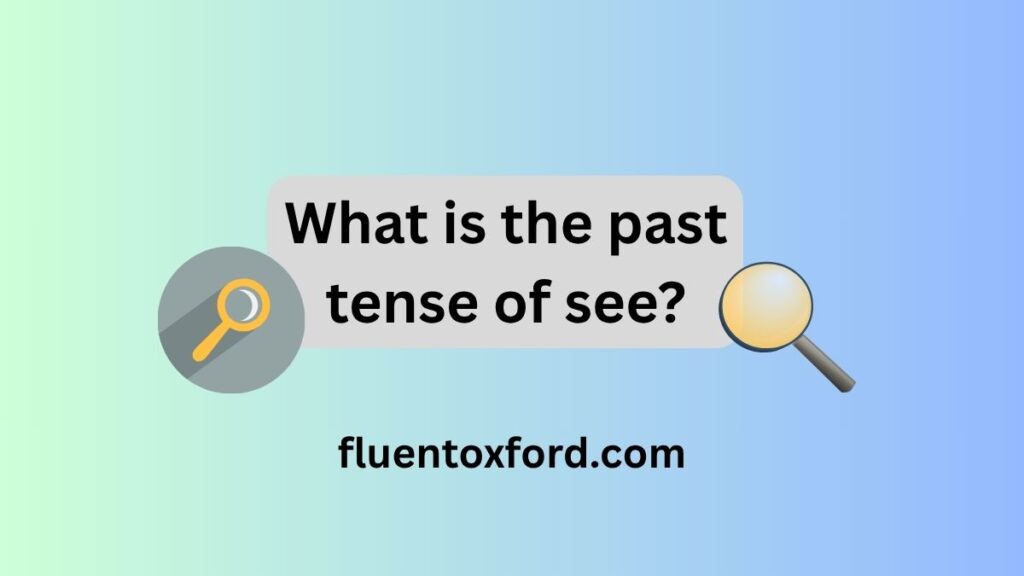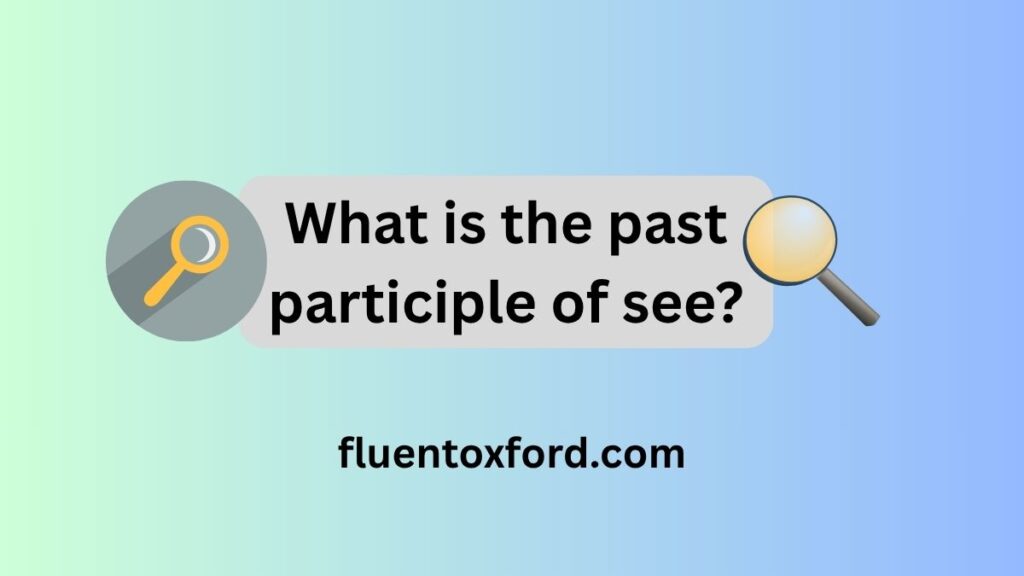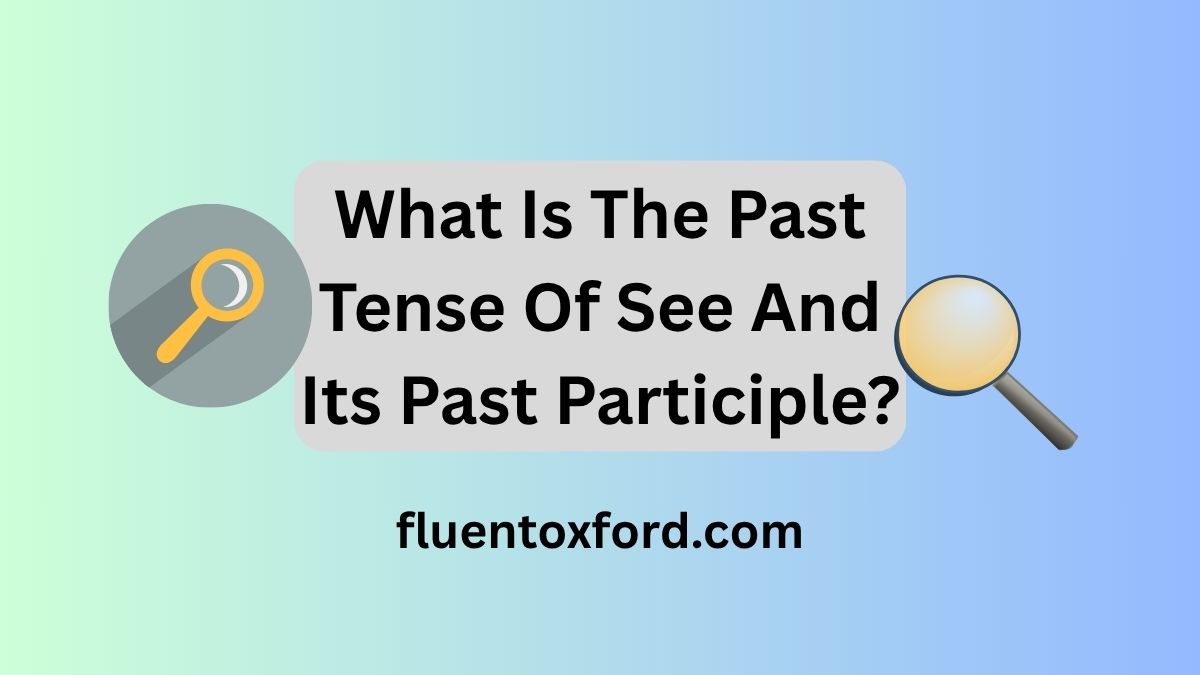The phrase “What is the Past Tense of See and its Past Participle?” refers to understanding the grammatical transformation of the verb “see” when describing completed actions or experiences in the past. In English grammar, verbs change form depending on the tense being used, and “see” is an irregular verb, meaning its past forms do not follow the typical “-ed” ending pattern. This concept is essential for proper sentence construction and accurate expression in both spoken and written communication.
Imagine crafting a beautiful story or recalling an unforgettable experience, only to hesitate when describing it in the past. The correct use of verb forms can turn dull narration into a vivid account. Mastering irregular verbs like “see” adds depth and fluency to your English, making your language skills sound more natural and polished. With just a small effort, you can elevate your grammar and storytelling.
Understanding what is the past tense of see and its past participle? opens the door to mastering one of the most commonly used irregular verbs in English. Whether you’re writing essays, speaking in public, or just having a casual conversation, knowing what is the past tense of see and its past participle? is crucial. For students, professionals, and language learners, the clarity around what is the past tense of see and its past participle? ensures you avoid common grammatical mistakes and sound more confident.
Understanding the Verb See: Present, Past, and Beyond
The verb see is one of the most commonly used irregular verbs in English. It’s essential for expressing experiences in the past, observations, and storytelling. Understanding the verb “see” means knowing its forms: “see” (present), “saw” (past), and “seen” (past participle). Each is used in different tenses to show time clearly.
Verb Conjugation of ‘See’
| Tense Form | Verb | Example |
| Base (Present) | see | I see the sunrise every morning. |
| Simple Past | saw | I saw a shooting star last night. |
| Past Participle | seen | I have seen this movie before. |
Unlike regular verbs that simply add “-ed,” see follows an irregular pattern—this is why learning past tense verbs like this one can be confusing at first.
What is the past tense of see?

Correct Form: Saw
The past tense of “see” is “saw.” This form is used for actions that were completed in the past, typically with clear time markers like “yesterday,” “last night,” or “in 2010.”
✅ Examples of Saw in Sentences:
- “I saw the eclipse last night.”
- “She saw the email but didn’t respond.”
- “They saw the results of the experiment.”
Using Saw in Different Sentence Types
Knowing when to use saw isn’t just about past events—it’s also about sentence structure.
✏️ Declarative:
“We saw a bear while hiking.”
✏️ Interrogative:
“Did you see the fireworks last night?”
(Note: You use “see” after “did,” not “saw.”)
✏️ Negative:
“I didn’t see the message.”
(Again, see is used, not saw, after didn’t.)
Time Markers Commonly Used with Saw
| Time Marker | Example Sentence |
| Yesterday | I saw her yesterday at the store. |
| Last night/week | We saw a movie last night. |
| Two days ago | He saw the news two days ago. |
| In [specific year] | She saw him in 2015. |
Using these grammatical time references helps place the action in a clear, defined moment in the past.
What is the past participle of see?

Correct Form: Seen
The past participle of “see” is “seen.” You never use “seen” on its own—it always needs a helping verb, like “have,” “has,” or “had.”
❗Wrong: “I seen the movie.”
✅ Right: “I have seen the movie.”
This is one of the most common verb mistakes, especially in informal speech.
Using Seen in Perfect Tenses
The past participle form is used in all the perfect tenses, helping to express experience, result, or completion of an action.
🔸 Present Perfect:
“I have seen that before.”
(An action with relevance to now)
🔸 Past Perfect:
“They had seen the warning signs.”
(Completed before another past action)
🔸 Future Perfect:
“By next week, you will have seen all the episodes.”
(Will be completed by a future time)
These examples show how tense transformation works when you’re moving through time in your storytelling.
Examples of Seen in Context
| Tense | Sentence Example |
| Present Perfect | She has seen this kind of weather before. |
| Past Perfect | He had seen the signs but ignored them. |
| Future Perfect | We will have seen all the chapters by then. |
Understanding how seen works is critical for storytelling in past tense and for expressing experiences in the past.
Common Mistakes Learners Make with See Forms
Mixing Up Saw and Seen
One of the most frequent mistakes learners make is saying “I seen” instead of “I saw” or “I have seen.” Let’s clear that up.
❌ Incorrect:
- “I seen him yesterday.”
✅ Correct:
- “I saw him yesterday.” (Simple Past)
- “I have seen him before.” (Present Perfect)
A good rule of thumb:
Use seen only with have, has, or had.
Overusing Seen in Casual Speech
In casual conversations, people often say “I seen it” because it sounds familiar. But over time, this habit undermines proper verb structure and makes writing sound less polished.
✨ Quick Fix: Practice speaking and writing sentences with “have seen” and “had seen until it becomes second nature.
Misusing Tenses in Compound Sentences
Tense misuse often happens in complex sentence structures, especially when describing sequences of events.
❌ Wrong:
- “After I saw the ad, I have seen the product in stores.”
✅ Correct:
- “After I saw the ad, I saw the product in stores.”
- “After I had seen the ad, I went to the store.”
Understanding grammatical time reference helps maintain consistency in storytelling.
Tips to Master See, Saw, and Seen

To master “see,” “saw,” and “seen,” practice using them in short sentences. “See” is present, “saw” is past, and “seen” needs “have” or “had.” Read often, listen to native speakers, and do grammar exercises. Focus on context to understand when each form is used correctly.
Here’s how to get comfortable with the different English verb forms for see.
Visual Mnemonics and Analogies
- Saw = A snapshot in time. You saw it once, clearly.
- Seen = A collection of memories. You’ve seen it happen many times.
“I saw lightning once. I’ve seen storms all my life.”
This analogy helps explain the differences between “see” and “saw” and when to use “seen.”
Practice Exercises: Spot the Error
Fill in the blank with “saw” or “seen”:
- I _____ a dog chasing a squirrel.
- She has _____ that movie already.
- We _____ the parade last year.
- They have never _____ a whale before.
- He _____ the message but didn’t reply.
Answers:
- saw
- seen
- saw
- seen
- saw
Practicing like this can help reinforce correct verb forms and reduce errors.
Quick Reference Table for ‘See’ Verb Forms
| Tense | Helping Verb | Main Verb | Example |
| Simple Present | — | see | I see the problem. |
| Simple Past | — | saw | I saw the problem. |
| Present Perfect | have/has | seen | I have seen that mistake before. |
| Past Perfect | had | seen | They had seen the memo already. |
| Future Perfect | will have | seen | She will have seen the update by then. |
This chart is perfect for ESL learners, grammar help, and quick reviews before writing assignments or exams.
Quote to Remember:
“Language shapes the way we think and determines what we can think about.” — Benjamin Lee Whorf
Conclusion
In conclusion, what is the past tense of see and its past participle? is very important for correct English. The past tense of “see” is “saw,” and the past participle is “seen.” These forms help us talk about actions that happened before. Using them correctly makes your speech and writing clear and correct. This small rule makes a big difference in good communication.
Learning what is the past tense of see and its past participle? can help you avoid simple grammar mistakes. It is useful in school, work, and everyday life. The more you practice, the more natural it will feel. So keep using and remembering what is the past tense of see and its past participle? to improve your English. Clear grammar helps you speak with confidence and write with ease.
FAQs
FAQ 1: What is the past tense of see?
Answer: The past tense of see is saw (e.g., I saw a rainbow yesterday).
FAQ 2: What is the past participle of see?
Answer: The past participle of “see” is “seen,” and it must be used with a helper verb like “have,” “has,” or “had” (e.g., “She has seen that show”).
FAQ 3: Can you say “I seen it” in English?
Answer: No, that’s incorrect. Say, “I saw it,” or “I have seen it,” depending on the context.
FAQ 4: Why is see considered an irregular verb?
Answer: Because it doesn’t follow the regular “-ed” pattern in the past tense and past participle forms—saw and seen are irregular.
FAQ 5: Are “saw” and “seen” interchangeable?
Answer: No, “saw” is used without a helper verb in the simple past, while “seen” needs a helper verb to form perfect tenses.

As an admin at Fluent Oxford, Maida Queen is the driving force behind our vibrant learning community. With a deep passion for English language education, she ensures that our platform remains a dynamic, engaging, and supportive space for learners worldwide.
Maida expertly manages content, assists users with their grammar and fluency queries, and fosters an interactive environment where learning feels effortless and enjoyable. Whether you need guidance, motivation, or just a friendly face in the Fluent Oxford community, Maida is always there to help you reach your English language goals.








